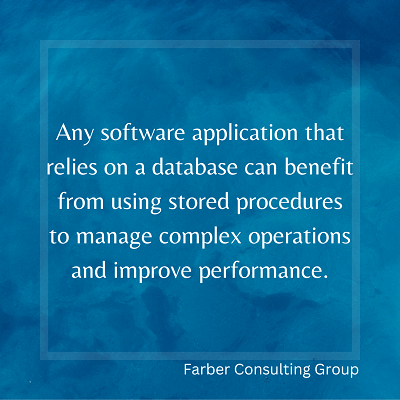Time is Money: Database Optimization for Your Business Logic
Boost the speed of your application while reducing resource consumption and the associated costs by optimizing the stored procedures in your database. It’s a simple process that makes a significant impact.
What is a Stored Procedure and How Does It Enhance Database Optimization?

A stored procedure is a block of code inside your database that can be executed on demand by a user or application. Stored procedures are used to perform complex database operations to execute the organization's business logic using the application.
That logic is based on the day-to-day operations of a business. It can be answers that are needed every day. It can be the boundaries of what is and isn’t relevant or allowed inside a business plan.
It is the nuts and bolts of what you do, especially the things you do differently.
Stored procedures are a valuable tool for managing the complexity of database operations. If done properly, you can leverage them to improve the performance and security of any software application.
A good custom software developer can optimize your database by using stored procedures to reduce the amount of code that needs to be executed by your application.
This gives you several advantages:
🏆 Improve the performance of your applications for your users.
🏆 Reduce security vulnerabilities to protect your data from unauthorized users.
🏆 Reduce the amount of computing resources your software needs to run.
🏆 Reduce latency by enabling more of your operations to call the stored procedures rather than the database itself.
Why are Stored Procedures so Important?

Various types of business logic can be put inside stored procedures. Some are simple, others complex:
🧩 Enforcing data validation rules like ensuring required fields are filled in, or data is within acceptable ranges.
🧩 Business rules like calculating pricing, applying discounts, or determining eligibility for promotions.
🧩 Complex queries that involve multiple tables and conditions. This is where we can produce quality database optimization for you.
🧩 Workflow rules like routing data to specific users or departments based on certain criteria.
🧩 Transactions, which ensure that a series of database operations either succeed or fail as a group.
Stored procedures are where you computerize your business logic. The more complex procedures are usually linked to the unique way you run your business – which produces the value only you can deliver. The most complex code underwrites your biggest strengths.
A Good SQL Consultant Wins on Time and Money with Better Stored Procedures:
As custom software developers and SQL consultants, our job is to learn from you.our job is to learn from you. We need to know how you operate to best understand the business logic behind the coding of your stored procedures.
We have to ask:
❔ Why is your business logic the way it is?
❔ What processes are you trying to digitalize?
❔ What is the goal of each business procedure?
❔ Why is its implementation taking the route it is throughout your software?
This tells us your business logic, how your stored procedures are currently routed and coded, and how they should be routed and coded.
This is where your database optimization takes shape.
How Poorly Coded Business Logic Stuffs up a Database?
Your custom software developer can quickly diagnose where you are paying too much in time and money to run your applications.
The first task is simply to take a look at the internals of the server your stored procedures are running on.
By analyzing the cache and using some monitoring tools, we get a list of your stored procedures and their performance level, CPU time required, I/O data, and other technical details.
Many stored procedures that need work will stand out at first glance.
When the numbers spike, it’s time to examine the procedure itself. The code underwrites a business process that can be overrun with excessive loops, logic trees, and batch calculations. A single process can be required to recalculate the same qiockl multiple times.
It’s almost the equivalent of looking behind your computer station for the first time in a year and realizing that what used to be ordered wires for your external hardware has become spaghetti city. It might take a while to reroute every wire to run in an ordered manner, but it’s worth it.
Sometimes, performance is killed because your database has bad traffic cops. What happens when you have 500 users of your applications all asking questions? They will query the database all at once, and you need an efficient way to decide who goes in, who goes out, and in what order.
One pleasant surprise about database optimization is that there are as many things you can do that don’t require any coding. To install the best traffic cop to move users in and out of your database as quickly as possible can be a matter of reconfiguring your database – and not creating a single line of code which would require a new round of testing.
Turning Time into Money with Practical Database Optimization:
The first steps are configurations. Can we change the defaults or what is currently there to fine-tune your database to run faster? Then we look into the network. Are there any fixes that can be made?
Now, we look into your code.
We look for where we can improve the code, replace it, or restructure the procedure to make things more efficient.
If we diagnose code that isn’t working the way it should or see clearly underperforming functions, we will ask you. Sometimes, code is written in a certain way because it’s the only way to support a specific manner in which you do business.
Where we can make improvements, we will.
For a lot of data queries, the requests are inefficient. It’s not because they were written that way. It’s because to accommodate new business needs, they were updated.
They were updated to meet immediate needs, which solved the urgent problem. Our job is to look at your entire codebase and see how many quick fixes disturbed the overall flow of your code.
We are the ones who can come in and say, “I see why you did these things, and I understand the challenges you had to meet on tight deadlines. Now, let’s rework this to continue delivering what you need, but in a more efficient manner and less costly in time and money.”
An experienced SQL consultant, who has seen every permutation of data queries at least a thousand times over, can look at the code and quickly identify what isn’t working optimally.
It can be an index that has been made multiple times. It can be a query that pieces together the wrong data sets. It can be a simple data request that first asks the database to scan millions of rows to pick up a single piece of information.
This is where we remove unnecessary indexes and add ones that aren’t there. We combine multiple indexes into a single index. We look for functions that, instead of returning answers, call other functions that call other functions.
We Know the Three Secrets to Database Optimization:
Most of the time, indexes need to be improved. But that doesn’t necessarily mean we change the code right away.
The reason is database optimization secret #1: Every time you change the code, you must test everything.
You have to test the indexes. You have to test all the other queries. You have to test buttons, functions, and features that have zero connection to this particular code block.
You have to ensure that the changes didn’t disable or downgrade any functionality or performance of your application.
When you look at indexes, see if you can first delete a duplicate index or add a new one to reduce the DevOps and QA overhead involved.
Here is the second secret: Data may be the most exciting part of an application, but managing how you work with it is the least exciting.
To avoid the painstaking task of managing the database queries and the data layer itself, many application developers will rely on the default configurations and basic database settings already there.
The bad news is that a lot of opportunity for quality database optimization is lost. The good news is that an effective SQL Consultant team has a lot of places to slim down your database ops. There are many places where you can upgrade the performance of your application by fine-tuning not the code but the settings of the data tool that executes it.
When we see things that need improvement, we first ask ourselves:
⬈ Can we change the database settings?
⬈ Can we change the server settings?
⬈ Can we change the file location?
⬈ Can we work with the database nodes in a cluster to see if they can work together in a greater tandem?
⬈ Can we change how the database availability is structured?
This leads us to the third secret:
Some of the best things can be done without changing the code.
Last but not Least: The Code
Changing the code is the last step in the process.
We can change a single function by altering just a few lines of code.
But if that function is inside 50 stored procedures, you must test them all.
How do we do it?
We look at the stored procedure and inspect its dependents and the parameters they are running on.
Complexity expands when logic is built into a function, and the functions are reused into other codes, functions, or stored procedures. It can be that a company’s business operations for something are so delicate the code has to remain the way it is.
We will create inline code to boost performance – even if we have to make alterations to change each function one at a time so you don’t lose the logic.
What happens when functions call other functions which call other functions to the 10th degree? We go through every function to see where we can make improvements.
Every Application Needs a SQL Consultant for Quality Database Optimization:
Whether you are a finance company, insurance company, manufacturing business, or even a cutting-edge IT startup, you need a fast-moving database to receive and send information to your employees, suppliers, and customers.
Our job is to ensure your optimizations are efficient and painless, boosting your application speed while reducing your resource consumption and cloud outlays.
We do this in the most thorough and least intrusive manner, making your software run like it’s brand new.
Making your web applications perform amazing feats with an optimized data platform is what we do. I am happy to talk with you about it at your convenience. Either contact us or call us at: 732-536-4765


Comments